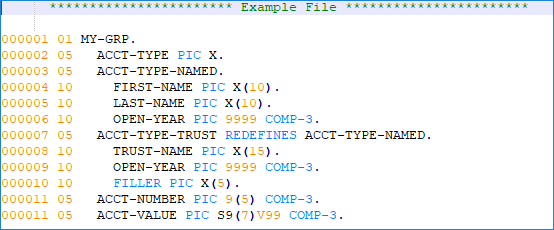Read metadata from Copybook
The Read metadata from Copybook step reads a binary fixed-length copybook definition file and outputs the file and column descriptor information as fields to PDI rows. You can then use these rows with the ETL Metadata Injection step to populate the Copybook Input step. Also, you can use this step to create a metadata template for multiple data files or to create a data model for a relational database. See Copybook steps in PDI for more information.
This step is required to use metadata injection with the Copybook Input step.
General
- Step name: Specify the unique name of the step on the canvas. You can customize the name or leave it as the default.

These options define the location of the copybook definition file and include mapping options for the binary data files.
| Option | Description |
| COBOL Copybook file path | Specify the file path to the copybook definition file. You can enter any VFS or SFTP file path, or click Browse to open the system file browser. After selecting a file, click Validate to verify that the definition file can be accessed and parsed. |
| COBOL Copybook line structure | Specify the line structure of the definition file:
|
Use these options to describe the binary format of the selected file:
| Option | Description |
| Source architecture | Select the machine architecture of the binary data source files. The values are:
|
| Source charset name | Select the character encoding set for the binary data file.
Mainframe EBCDIC is typically encoded using IBM037 or cp1047 character sets. For more information about character sets and their aliases, see Supported Encodings in the Oracle® documentation. |
| Packed decimal (COMP-3) convention |
Select how COMP-3 packed decimals are parsed when reading the binary data at runtime of the Copybook Input step.
|
Use this option to include the metadata of the parent group in the definition file.
- Extract parent groups?: Select this check box if you want to include parent group metadata in the output stream. Clear this check box to exclude parent group metadata from the output stream.
Example
In this example, we are using the accounts.cbl sample copybook definition file available in the design-tools/data-integration/samples/transformations/copybook/redefines_example/accounts.cbl directory.

The Standard columns (6 to 72) option was selected to match the file format. The Extract parent groups option was selected to include the group information. The following image shows how the data displays in the PDI stream after running the transformation using the sample file.

The field_kettle_type column displays the data types that are generated to the PDI stream.
Metadata injection support
All fields of this step support metadata injection. You can use this step with ETL metadata injection to pass metadata to your transformation at runtime.

